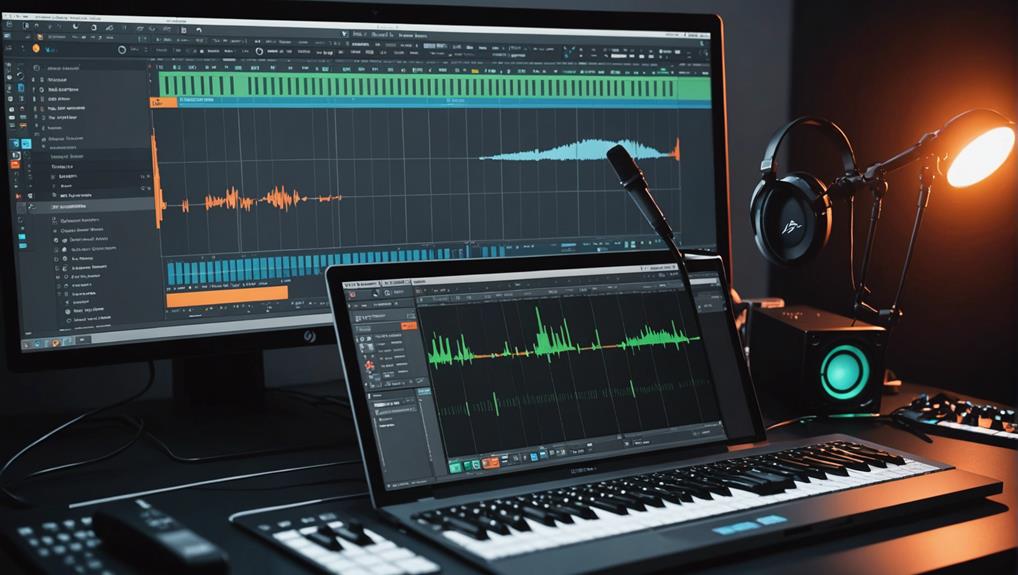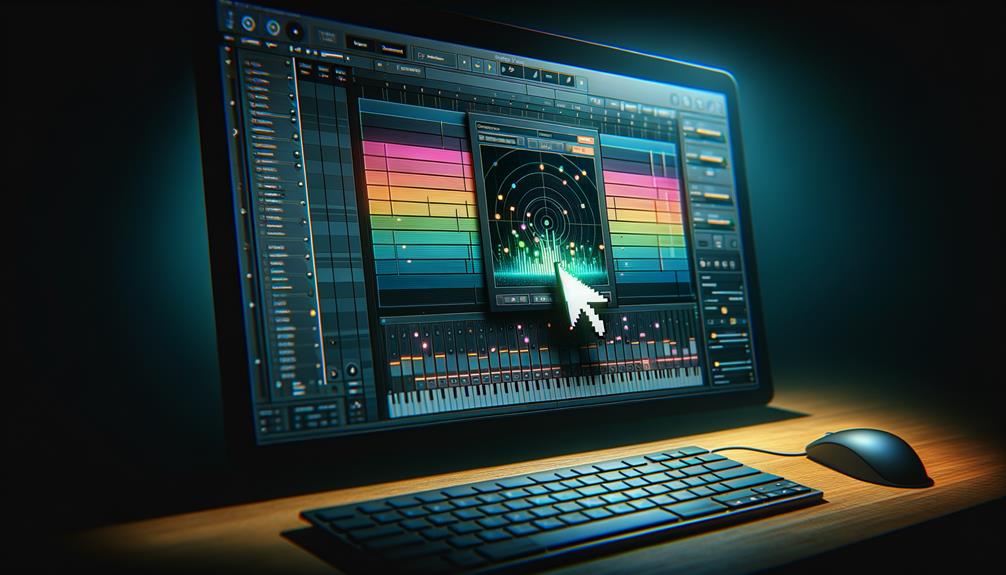To start recording in FL Studio, set up your gear with a condenser microphone and connect it to an audio interface. Install FL Studio and adjust your audio settings for peak performance. Next, prepare a mixer track by selecting the microphone input and arming it for recording. Keep gain levels between -16 to -12 dB to avoid clipping. When you’re ready, hit record in a quiet space to capture your sound clearly. Experiment with layering and mixing techniques for a polished output. There’s plenty more to explore that can enhance your recordings and mixing prowess.
Key Takeaways
- Set up your condenser microphone with an audio interface, ensuring phantom power is activated last for optimal vocal capture.
- Configure FL Studio’s audio settings and select the appropriate ASIO driver for best performance.
- Arm a blank mixer track for recording, adjusting gain levels to avoid clipping and ensure clear audio.
- Record in a quiet environment, using headphones to monitor sound and prevent feedback during the recording process.
- Edit and mix your vocal tracks using EQ, compression, and effects for a polished final product.
Setting Up Your Equipment
When you’re ready to start recording in FL Studio, setting up your equipment correctly is essential for achieving high-quality sound.
Begin with a condenser microphone, as it captures vocals effectively. Connect it to your audio interface using an XLR cable, ensuring everything is connected before activating phantom power; this prevents damage to your microphone.
Place your mic on a sturdy mic stand and position it to capture your voice clearly. To enhance your recording environment, use a pop filter to minimize plosive sounds that can distort your audio. Additionally, consider using an audio interface to ensure quality sound when connecting your microphone.
Finally, regularly maintain your recording equipment by storing it properly and cleaning it, ensuring consistent performance during your sessions.
With this setup, you’re on your way to great recordings!
Configuring FL Studio Settings
Configuring FL Studio settings is essential for a smooth recording experience. Start by opening FL Studio and directing yourself to Options > Audio Settings.
Here, select the appropriate ASIO driver for your audio interface, like the Presonus Audiobox iTwo. Set the buffer size to around 256 samples to reduce audio clicks; if issues arise, adjust it to 512 samples. Confirm the sample rate is set to 44.1 kHz for CD quality, or 48 kHz for better recordings. It’s also important to ensure that your audio interface is compatible with AU plugins to maximize your recording capabilities.
Don’t forget to create a new project with a clean template and set the BPM. Finally, arm the mixer track by choosing the correct input source and enabling the recording filter for your microphone input.
- Select the right ASIO driver
- Set buffer size for ideal performance
- Arm the mixer track for recording
Preparing the Mixer Track
To prepare your mixer track in FL Studio for recording, start by selecting a blank track and choosing the right input source for your microphone.
Next, arm the track for audio by right-clicking the record button and adjusting the gain levels to keep the meter between -16 to -12 dB.
This setup guarantees you capture clean sound without any interference, making your recording process smoother. Additionally, ensure you activate input monitoring to hear the incoming audio and confirm your setup before recording.
Setting Up Inputs
Setting up inputs in FL Studio is essential for ensuring your recordings are clean and professional. Start by locating a blank mixer track and select Input 1 from the dropdown menu, making sure the external input (EXT) is chosen. This setup helps avoid mixing internal audio, allowing for a clear capture of vocals or instruments.
Here’s what you need to do:
- Arm the mixer track for recording by right-clicking the record button.
- Set the gain while monitoring the meter, aiming for peaks between -16 to -12 dB.
- Use headphones during the recording to prevent sound bleed.
Adjusting Mixer Levels
Once you’ve set up your inputs, it’s time to focus on adjusting the mixer levels for ideal recording.
Start by selecting an empty mixer track and assign it to your microphone input. Adjust the gain levels to guarantee your input signal peaks between -16 to -12 dB on the meter to avoid clipping during recording vocals. If necessary, use the Fruity Balance plugin to fine-tune the gain for a clear sound.
Don’t forget to enable the record button on the mixer track by right-clicking and selecting the audio recording option. As you adjust the mixer track, monitor the levels to maintain clarity and prevent any unwanted distortion or background noise during your recording session.
Recording Techniques and Tips
When you’re recording vocals, effective microphone placement is key to capturing the best sound. Experiment with different positions to find the sweet spot that highlights your voice while minimizing background noise. Once you’ve nailed your main take, consider layering multiple vocal tracks to add depth and texture to your mix. Additionally, remember to use a pop filter to reduce plosives and ensure a cleaner vocal recording.
Effective Microphone Placement
Achieving great sound in your recordings hinges on effective microphone placement, so it’s essential to contemplate the distance and angle relative to the source.
Position the microphone 6 to 12 inches from the vocalist’s mouth to capture clear sound and minimize plosive sounds. Use a pop filter for added protection. Angle the microphone slightly off-axis to reduce sibilance and promote natural sound capture.
Experiment with height, aligning it with the singer’s mouth for ideal vocal clarity and warmth.
- Test various positions and distances to find the sweet spot.
- Adjust based on the acoustics of your recording environment.
- Consider overhead placement for instruments or choirs to capture a wider sound field.
Layering Vocal Takes
After you’ve set up your microphone for ideal sound capture, it’s time to explore layering vocal takes to enrich your recording.
Start by recording multiple versions of the same phrase; this adds richness and depth to your Audio Track. In FL Studio Producer Edition, use the Playlist Track to organize and align these takes for precise editing.
Don’t forget to pan different layers slightly left and right in the mixer, creating a wider stereo channel. Add subtle variations in performance for uniqueness, and apply effects like reverb and delay selectively to craft depth without overwhelming the mix.
With your track armed, you’ll find that effective layering enhances the overall quality during mixing and mastering.
Managing Recorded Audio Clips
Managing recorded audio clips in FL Studio is essential for streamlining your workflow and enhancing your creative process. You can efficiently manage your clips by saving them in custom folders or using the default folder structure for easy access.
The Playlist allows you to visually arrange and layer multiple audio clips, making it easier to edit different takes for a cohesive sound.
- Use the Edison plugin for advanced recording and editing options.
- Route audio clips back to their original Mixer Track for seamless adjustments.
- Remember that deleting recordings is reversible until another action is taken or FL Studio is closed. Additionally, utilizing EQ tools can significantly improve the overall quality of your recordings.
Mixing and Final Touches
As you plunge into the mixing process, balancing vocal levels with instrumental elements becomes essential for a polished final product.
Start by adjusting the vocal levels in your mixer to guarantee they maintain presence throughout the track. Use equalization (EQ) to cut unwanted frequencies below 80 Hz and boost clarity around 3-5 kHz. Implement compression with a ratio of 3:1 to 5:1 to control the dynamic range of the vocals, keeping the loudest parts in check. Enhance spatial depth by adding reverb and delay effects, tweaking pre-delay settings for clarity. Additionally, consider using surgical EQ cuts to effectively isolate and remove resonant problem frequencies for even greater clarity in your mix.
Finally, automate volume and effect parameters to create dynamic changes, guaranteeing your vocals remain engaging while adapting to the evolving arrangement.
Frequently Asked Questions
How to Record on FL Studio Beginner?
To record in FL Studio, connect your audio interface, set track settings, and utilize software shortcuts. Follow recording tips, apply vocal techniques, and practice mixing basics for better sound quality and project organization.
Is FL Studio Easy to Learn?
Yes, FL Studio’s easy to learn. Its features for music production, recording techniques, audio editing, and MIDI integration simplify the process. You’ll enjoy the intuitive plugin usage and project organization, enhancing your sound design skills effectively.
Is It Easy to Record Vocals in FL Studio?
Yes, it’s easy to record vocals in FL Studio. Set up your mic and audio interface, monitor gain levels, use effective recording techniques, and apply vocal effects to enhance your performance during mixing.
How Do I Record Without Feedback in FL Studio?
To avoid feedback, you’ll want to use headphones, adjust mixer settings, and explore mic placement strategies. Implement feedback elimination techniques, monitor options explained, and select a suitable audio interface for ideal results.
Conclusion
Now that you’ve learned how to record in FL Studio, you’re ready to release your creativity! Remember to set up your equipment properly, configure your settings, and prepare your mixer track. Use the recording techniques and tips to capture your best takes, and don’t forget to manage your audio clips efficiently. With a little practice, you’ll be mixing and adding those final touches like a pro. Immerse yourself and have fun making music!



